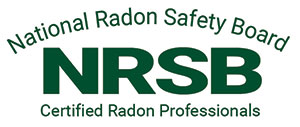ORGANIZATIONAL STRUCTURE
Organizational Structure
The overall structure of the National Radon Safety Board (NRSB) is based on the model of the American Board of Health Physics (ABHP) which is widely recognized as the premier qualifying body for radiation safety practitioners. The bylaws and the specific structure of the Board of Directors are based directly upon Environmental Protection Agency’s model of an independent National Radon Safety Board. Like the American Board of Health Physics, the NRSB depends almost entirely upon volunteers with professional responsibilities in the health risks, measurement, remediation, and public policies related to radon. In keeping with the EPA’s insistence that non-governmental certification of radon professionals would require a governing board comprised of radon stakeholders, the bylaws of the NRSB provide for the diverse representation of radon stakeholders on the Board. The fact that the NRSB is governed by professionals from both the public and private sectors of the radon field — and that all serve on a volunteer basis — provides the highest assurance that the public interest will always be protected.
Board of Directors: The Board of Directors is responsible for setting the standards, procedures, policies, and certification requirements of the National Radon Safety Board. In addition to annual meetings; the Board of Directors may introduce, debate, amend, and vote upon resolutions via electronic procedures.
Executive Committee: An executive committee consisting of the Officers of the corporation act as an executive committee to oversee operations on an ongoing basis; generally meeting by conference call the first week of each month and additionally as necessary.
Certification Panels: Operating under the direction of the Board are five panels with the responsibilities for establishing the specific criteria for each of the NRSB programs: certification of radon testers; certification of mitigators; the accreditation of laboratories; the accreditation of chambers, and the approval of radon measurement devices.
Oversight Committees: There are six committees for overseeing the general operations of the NRSB: the committees for professional standards; operating protocols; continuing education; government relations; public awareness; and the nomination of members to the Board of Directors.
Administration: Administrative services, including the processing of all certification applications and maintenance of certification lists, are provided under contract. The administrative service provider handles routine inquiries, the processing of applications, information mailings, exam administration and security.
Electronic Access: The National Radon Safety Board is electronically accessible through its website at WWW.NRSB.ORG and via e-mail at INFO@NRSB.ORG. The website provides current listings of all NRSB certified professionals and organizations, sorted by certification type, name, company, state, zip code and mileage radius. The website also links to important primary documents, state radon programs, and business documents relating to the conduct of the NRSB’s public service mission.
Because the National Radon Safety Board is a single purpose, nonprofit organization, matters of policy are decided by bona fide experts who volunteer their services. This structure assures the highest level of expertise, avoids conflicts of interests, and assures the lowest possible costs for the program, which in turn provides direct benefits to both the industry and the community it serves.
